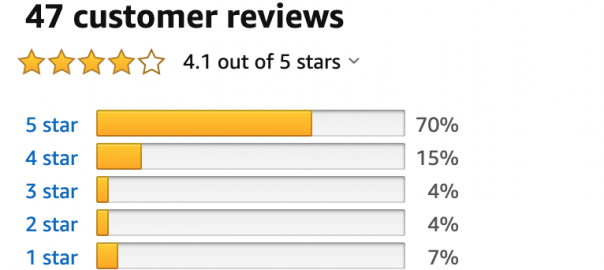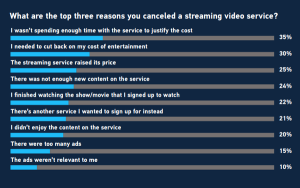— May 4, 2019
When talk turns to SEO, Google is the first name that comes to mind. But, it’s not the biggest name in retail search. That crown belongs to Amazon, which overtook Google as the most popular platform for product searches in 2015 with 54% of the share, according to a 2018 report. Yet the topic of optimising Amazon product listings doesn’t come up in many marketing discussions. In this article, we’re going to cover the basics of Amazon search marketing and how to maximise performance on the world’s largest eCommerce platform.
Getting to know Amazon’s A9 algorithm
In the same way Google’s search algorithm connects users with content, Amazon has its own algorithm to bring retailers and consumers together. The good news is that Amazon’s algorithm is far less complex than Google’s and, while optimising for an Amazon product listing is different from the kind of SEO you might be used to, it’s much easier to get your head around.
The fact is Amazon’s algorithm doesn’t need to be as sophisticated as Google’s because people only use it for one thing – finding products.
Google’s algorithm needs to understand user queries to such an extent that it can differentiate product searches from content searches, local searches from location-independent searches, and all kinds of other use cases.
That’s not to say optimising for Amazon is a piece of cake, but it’s relatively straightforward conceptually and easier to explain in the scope of a single article.
Amazon organic listings vs paid ads
Something else Amazon has in common with Google is that there are two types of listings; organic results and paid search results. Paid listings appear at the top of results pages, based on the keywords users type in, and then users can scroll down to see organic results.
As with any kind of SEO strategy, you’re going to get the best results by combining your organic search strategy with paid ads on Amazon. There are two main ad formats that you need to know about.
Sponsored Products
Sponsored Products appear on product result pages in the same format as organic listings do, except they appear at the top of the page with a “Sponsored” label above the headline. These ads can also appear alongside or within other Amazon product listings and even on product pages themselves.
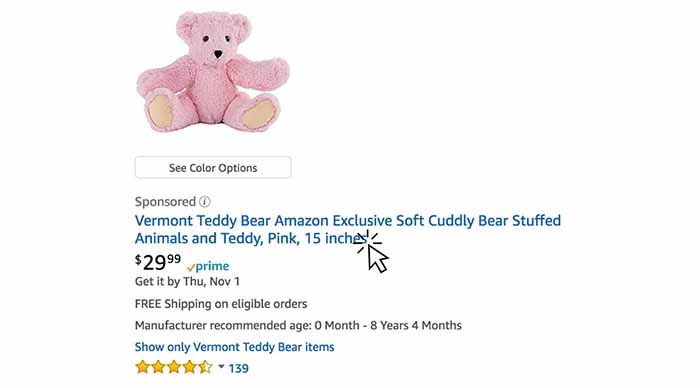
Sponsored Brands
Sponsored Brands (previously called Headline Ads) allow you to promote multiple products sold by your brand. You can add your logo and a branded message to encourage users to take a look at more of your products.
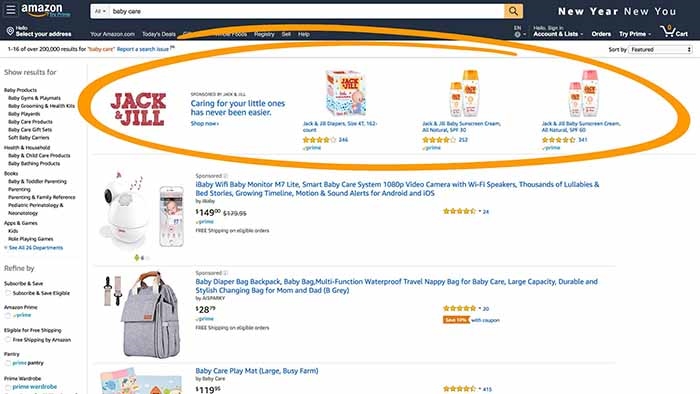
Once again, your advertising options are more basic on Amazon than you might be used to with Google Ads. But, you don’t need as many ad formats or targeting options because it’s all about those product searches. This means you get high purchase intent from targeted consumers right from the start.
Optimising your organic Amazon product listing
When you’re optimising for search engines like Google and Bing, you’ll generally divide tasks into on-page tasks and off-page tasks. The same thing applies to Amazon SEO so we’ll cover these two topics separately in this section.
Amazon on-page SEO
On-page Amazon SEO focuses on your product listings. There are five key areas you need to optimise:
- Product listing title
- Bullet points
- Product description
- Back-end keywords
- Product images
Let’s run through each of these elements in more detail to give you a blueprint to follow:
1. Optimising Amazon product listing titles
Much like page titles are a fundamental ranking factor for search engines, the titles of your product listings play the same kind of role within Amazon. These titles give Amazon’s algorithm and users vital information about your products.
Here are some optimisation tips:
- Include your primary keywords
- Include your brand name in the title
- Include product variations (sizes, colours, models)
- Include defining features (e.g. 4K vs 8K TVs, men’s vs women’s clothing etc)
Keep an eye on title lengths and make sure you optimise for mobile, as this is where a lot of browsing takes place on Amazon. Ideally, you want your titles to be readable and compelling but you also need to make sure all the relevant information is included.
Keep it relevant, avoid keyword stuffing at all costs and remove any unnecessary wording that’s taking up space without adding value.
2. Bullet points
Bullet points are the most important descriptive text on your product listings. This is where you communicate the key benefits and standout features of your products. Bullet points are much easier to read than solid text. This is the part of your listing that people are going to quickly scan and decide whether they want to know more about your product.
Make these count.
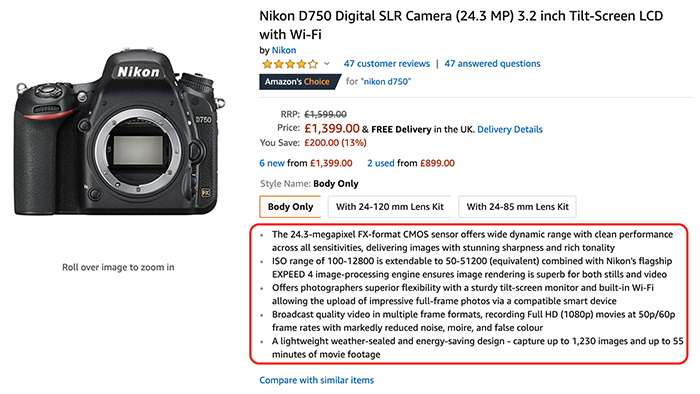
3. Product description
By default, Amazon product descriptions are HTML blocks of text, so it’s difficult to make anything compelling out of these. All you can really do with standard product descriptions is include any additional information about your products users might want to know, even if it’s not going to clinch the deal.
If you’re eligible, it’s definitely worth signing up to Amazon Brand Registry, which allows you to create visually engaging product descriptions with images and styled text. These are a major upgrade over standard product descriptions, turning your listing into something more like a product landing page.
4. Back-end keywords
Back-end keywords are search terms you define for your listings to help Amazon understand more about what your products are. These are kind of like meta tags that tell Google what your web pages are about.
You’ve got limited space to work with though, so you’ll want to define these as long-tail keywords that include multiple search terms. For example, if your product is a pair of Nike women’s running shoes, put “Nike women’s running shoes” as a single keyword rather than typing out “Nike”, “shoes”, “women’s shoes” “running shoes” and all the other variations you can think of.
In this case, “Nike women’s running shoes” has you covered.
5. Product images
Images are crucial to any Amazon product listing. First of all, make sure you follow the company’s guidelines for the primary images of your products (the ones that actually show up in search results).
These guidelines vary, depending on the specific type of product:
- The image must be the cover art or a professional photograph of the product being sold. Drawings or illustrations of the product are not allowed.
- The image must not contain gratuitous or confusing additional objects.
- The image must be in focus, professionally lit and photographed or scanned, with realistic colour and smooth edges.
- Books, music and video/DVD images should be the front cover art, and fill 100% of the image frame. Jewel cases, promotional stickers, and cellophane are not allowed.
- All other products should fill 85% or more of the image frame.
- The full product must be in frame.
- Backgrounds must be pure white (RGB 255 ,255, 255).
- The image must not contain additional text, graphics or inset images.
Make sure product images are on a white background and large enough for users to zoom in and have a good look at the item. Amazon recommends images of at least 1280 pixels on the longest side but you should really go with a minimum of 2560 pixels for today’s ultra-HD devices.
Amazon off-page SEO
There are four key things that determine how often and how prominently your Amazon product listing appears in results for relevant queries:
- Sales volume
- Unit session percentage
- Product prices
- Amazon reviews
1. Sales volume
Amazon wants to sell as many products as possible so it shouldn’t come as a surprise that sales volume is one of the most important off-page ranking factors. While we don’t know the exact workings of Amazon’s A9 algorithm, sales are clearly a key factor. There are different types of sales that appear to have a varying degree of value:
- First you have on-site, fully priced sales where users on Amazon type in keywords, find your products and make the purchase.
- There are also inbound traffic sales where visitors click through from another site before making the purchase.
- Finally, there are discounted product sales and these appear to have lost value in Amazon’s A9 algorithm in recent years.
The most valuable type of sale on Amazon is on-site, fully-priced sales and the more of these you have for any specific product, the more prominently it will appear in search results.
2. Unit session percentage
With Amazon, you don’t get a great deal of analytics reporting built-in, but one important metric you want to keep track of is your unit session percentage. This tells you the number of products that are sold on average per visit to your product page.
This is the closest you’ll get to a conversion rate metric for your Amazon product listing. Needless to say, this is a crucial KPI that provides an overall indication of how well your listing is turning visitors into paying customers.
3. Product prices
Pricing is always a key factor when consumers make any kind of buying choice and Amazon allows people to compare your goods (and prices) with hundreds or thousands of competitors. So it’s important you understand what your rivals are charging for similar products and make sure you’re competitive.
If your products are more expensive, make it clear why people should expect to pay more. If there’s no good reason, you’ve got a problem and Amazon’s algorithm will automatically mark you down if it finds you’re more expensive than the competition.
4. Amazon reviews
One of the most important elements of Amazon as a platform for consumers is its reviews system. This helps people buy with confidence and gives retailers the edge if they’ve got a strong collection of positive reviews for their products.
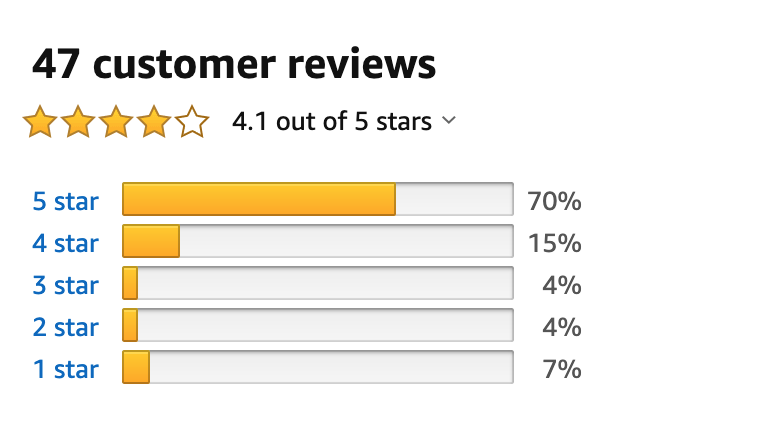
Naturally, these reviews are going to directly impact your sales and, in turn, your overall performance in Amazon.
Make reviews a core part of your strategy and aim to deliver the best possible service beyond the sale itself. Unless you’re manufacturing your own products, there’s not much you can do about malfunctions or user issues, aside from potentially switching to alternative products.
However, you’re 100% in control of how you deal with customer service after the sale. You’ll often find this is what influences user feedback more than the item itself.
Amazon is the world’s biggest eCommerce platform, handling more product searches on a monthly basis than Google. It’s also a lot easier to optimise for, thanks to its relatively simple algorithm. Make no mistake, this is a crucial platform for today’s retailers and it’s one of the first places consumers go when they’re looking to buy products.
Digital & Social Articles on Business 2 Community
(26)
Report Post